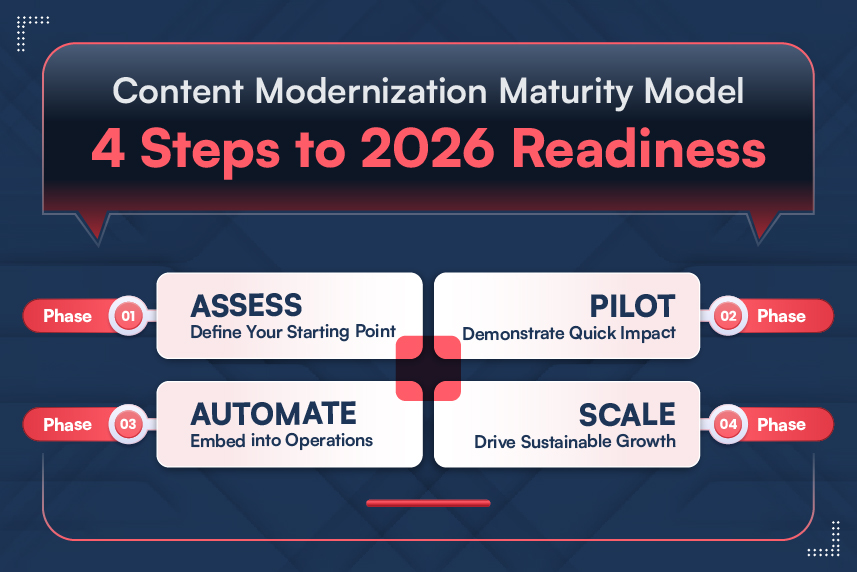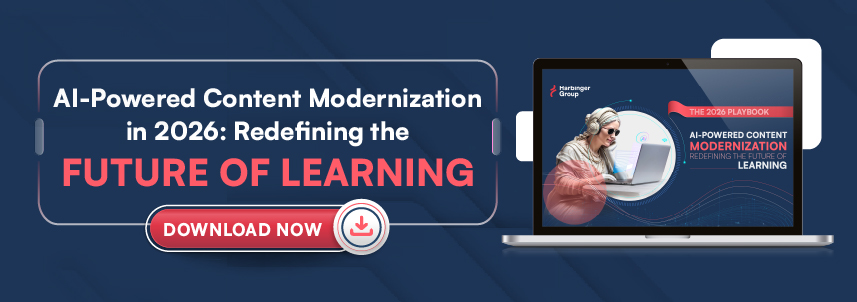
A quiet shift is reshaping the digital publishing landscape. In speaking with publishers, platform leaders, and enterprise L&D executives this year, one pattern is unmistakable:
“The content that got us here won’t get us there.”
Large libraries can no longer defend market position. Learners want richer experiences, enterprises demand skills alignment, and platforms expect continuous modernization. 2026 will belong to publishers who shift from being content factories to continuous learning engines.
As someone deeply involved in content modernization strategy for publishers, associations, and learning providers, here’s a practical and actionable roadmap for leaders planning how to modernize their content ecosystems in 2026.
Modernization: A Boardroom Priority in 2026
Across multiple conversations, four realities are driving modernization from “nice-to-have” to “non-negotiable.”
1. Experiences—not libraries—are the new differentiator.
AI can now summarize, reformat, translate, tag, and recombine content faster than humans ever could. Customers increasingly prefer publishers who offer flexible, multi-format learning experiences, not static courses.
2. Learning now lives inside workflow tools.
Slack, Teams, Salesforce, and conversational AI platforms are becoming the “new LMS.” Learners expect content to be searchable, modular, and instantly available, not buried three clicks deep in an LMS.
3. Skills-first design is the default expectation.
From workforce development to continuing education, buyers now evaluate publishers on their ability to map content to skills, behaviors, and outcomes. Publishers who cannot articulate the skills their content builds are being filtered out early in enterprise evaluations.
4. Content freshness has become a currency.
A growing number of enterprise buyers now ask:
“When was this last updated?”
In regulated industries (OSHA, ISO, state boards), outdated content is a compliance risk, not a cosmetic issue.
What Modernization Truly Means in 2026
Modernization is evolving from a conversion exercise to a strategic capability. Four pillars define this shift:
1. Structurally intelligent, searchable content
Platforms like Coursera, Adobe Learning Manager, and modern LXPs are enabling semantic search – learners expect to search inside content at sentence-level granularity. Some LMS/LXPs are also auto-suggesting learning snippets at the point of need.
2. Multi-modal learning from a single source
Publishers are increasingly asked for:
- Micro-videos
- Infographics
- Summaries
- Quizzes
- Job aids
- Conversational responses
And these requests now appear directly in RFPs.
3. Agentic AI workflows integrated into content operations
Examples include:
- Automated tagging
- Deduplication scans
- Reusability scoring
- Accessibility checks
- Localization automation
- Course → micro-learning conversion
- Update triggers for regulatory changes
4. Skills-aligned content ecosystems
Modern buyers want clear skill outcomes, mapped proficiency levels, and aligned job behaviors.
Here’s an extensive guide on what AI-Powered Content Modernization will look like in 2026, featuring expert insights from 7 global leaders.
The Pitfalls Most Publishers Underestimate (and How to Fix Them)
1. Decentralized repositories → Create a unified content source of truth
Problem: inconsistent taxonomies, multiple versions, scattered SCORMs. AI can’t solve content chaos – it magnifies it.
Solution: run a metadata audit, consolidate repositories, standardize taxonomies.
2. Legacy systems → Build an interoperability plan
Problem: LMS platforms without APIs hinder AI adoption. Several publishers echo the same concern: “Our content is modern, but making it available seamlessly across systems is difficult.”
Solution: invest in API-ready systems and headless delivery models.
3. Human–AI skill gaps → Establish new hybrid roles
Problem: IDs/SMEs alone will not be sufficient to operate future AI content workflows.
Solution: Consider adding roles such as content AI engineers, AI QA reviewers, semantic taxonomists, and rights curators.
4. Trust and accuracy concerns → Build AI governance
Problem: In compliance-focused sectors (safety, healthcare, manufacturing), leaders are open to AI but fear hallucinations, source-of-truth alignment, rights management, and compliance risks.
Solution: create a human-in-the-loop, audit-driven validation framework.
5. Outdated business models → Reimagine monetization
Problem: flat AI fees and per-seat models no longer attract enterprise buyers.
Solution: explore usage-based, value-based, or modular add-on models. Recently, Microsoft shared that they are thinking of agent-based pricing.
Innovation Pathways for 2026
1. Create AI-ready content structures
Start with a hygiene audit (taxonomy, metadata, duplication, versioning, skills mapping).
Without this foundation, AI is working blind.
2. Build scenario-based, practice-rich learning
This year, publishers repeatedly said:
“We want learners to apply skills, not just consume content.”
Tools such as scenario generators from Skillsoft and Adobe show where the market is headed.
3. Design for conversational environments
Learning increasingly happens through AI assistants and micro-moment prompts. To enable these experiences, Publishers must design content that is:
- Chunked
- Searchable
- Searchable
- Persona-aware
4. Personalize at scale
Modern LXPs already support adaptive branching, job-role personalization, dynamic content, and preferred learning formats. This is where learner engagement will be won.
5. Introduce continuous content updates
A compliance client recently shared:
“We still track OSHA updates manually in spreadsheets.”
AI can automate monitoring, detect changes, map them to content screens, and even make those updates while having human-in-the-loop to ensure quality.
A Content Modernization Roadmap for 2026 (Actionable & Measurable)
Harbinger has been consulting many of its large content library organizations on content modernization roadmap. A four-phase roadmap emerged as a pattern across many such conversations this year.

Phase 1: Assess (Establish Your Baseline)
Action steps:
- Portfolio audit (flag outdated, duplicated, low-usage content)
- Taxonomy cleanup
- Skills mapping
- Governance definition
- Business outcome alignment
Phase 2: Pilot (Prove Value Quickly)
Action steps:
- Convert 5–10 legacy courses into micro-learning
- Run AI-based tagging & metadata enrichment
- Extract videos → transcripts → summaries → quizzes
- Pilot accessibility & localization automation
- Convert a sample webinar into micro-learning journeys
- Convert static courses to engaging video-based and AI-scenario driven learning
Harbinger experience: For an insurance training provider, Harbinger helped convert multiple webinars into short eLearning reinforcement courses, infographic, and podcasts for key takeaways.
Phase 3: Automate (Operational Integration)
Action steps:
- Automated tagging pipelines
- Duplication detection
- Skills alignment engines
- RAG indexing for semantic search
- LMS/LXP API integration
Harbinger experience: Harbinger has helped multiple digital publishers integrate their LMS with over 300+ different systems (LMS, HRIS, ATS, CRM, Performance management systems and more).
Phase 4: Scale (Build the Evergreen Engine)
Action steps:
- Shift from projects to continuous workflows
- Multi-format delivery across channels
- Embed audit trails
- Establish a strong governance process
- Track impact: engagement, skills growth, retention
Harbinger experience: Harbinger has built generative AI-based content processing framework, iContent, which reimagines content development at scale. It supports features such as content generation with SME review, storyboard creation, audio recording, video generation, image creation, reinforcement learning, summarization, Rise development using automation, and assessment creation.
The Bottom Line: 2026 Belongs to Adaptive Publishers
The future of digital publishing lies in adaptive, AI-ready, multi-format content ecosystems – continuously refreshed and tightly aligned to skills and outcomes. This is not about replacing humans. It’s about enabling humans to focus on creativity, empathy, instructional integrity, and innovation. Publishers who start laying their foundations now- data, structure, skills, systems- will shape the future of learning. They will lead it.
Want to know how content modernization can change the game for your organization in 2026? Talk to our experts or write to us at contact@harbingergroup.com.






